Back when I first became interested in illustration from the mid-20th century, I found this piece below, signed "Lucia". I thought it was so great, I immediately sent it out to the Today's Inspiration group. I didn't know much about illustrators from the '50s back then, but I knew enough to catagorize this Lucia with the likes of Coby Whitmore, Joe Bowler, and Joe De Mers.
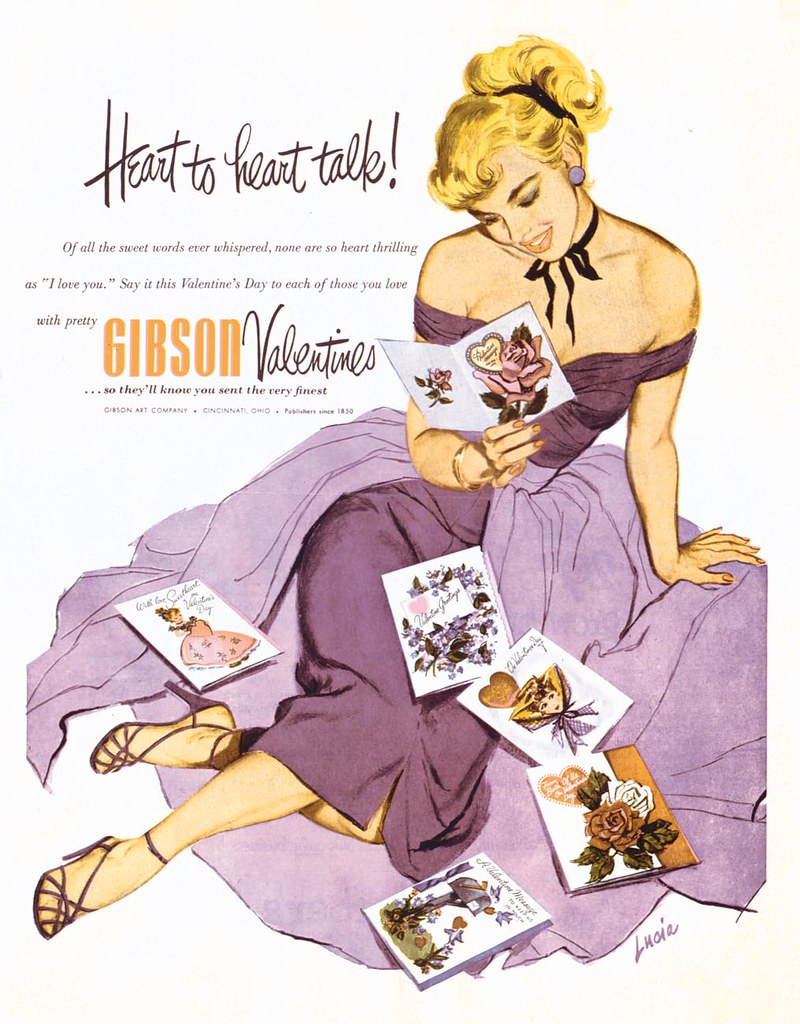
Lucia was clearly adept at painting georgous women in romantic settings. His work had a lively roughness, a sketchiness - that textural quality - that was emerging during the mid-fifties among the top boy/girl illustrators, especially those at the Cooper studio in New York.
I say "his" because at that time I presumed only male illustrators could have done work in this sort of style. Shows you how very little I knew at the time!
But with no listing in "Illustrator in America" and with my most knowledgeable contacts unable to shed any light on who "he" was, Lucia remained just a signature on the occassional magazine ad I came across. Lucia's accounts included Gibson greeting cards, Orlon textiles, and the Santa Fe rail line. For the longest time I thought Lucia was strictly an advertising illustrator... then I discovered pieces like this one below, proving that the artist had also done editorial work.

I found pieces in Collier's, American, and Better Living, always signed ( or even just credited ) with that single name: Lucia.
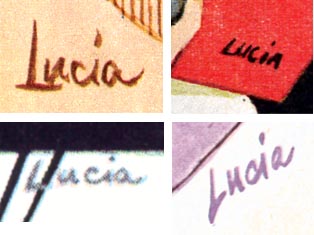
Then, in 2006, an email arrived out of the blue: "I have info about Lucia for you..."
Those seven words sent an electric thrill through me. An illustrator named Will Nelson had stumbled upon my post and decided to contact me.
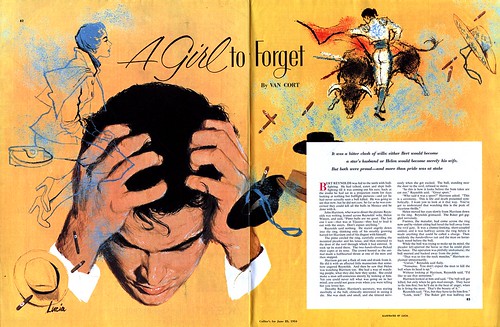
Will began relating to me his recollections of working as a young up-and-coming illustrator in the 1950's at the Chicago powerhouse art studio, Stephens, Biondi, DeCicco:
"When I came on board," wrote Will, "there were about ninety people in the organization. When I started right out of Art Center the head of the Los Angeles studio was Howie Forsberg, an illustrator, along with a staff which included Fritz Willis and Morgan"Joe"Henninger. It was in Chicago that I met Lucia (last name Larner)."
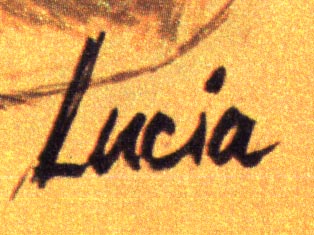
Hearing all this from Will absolutely blew my mind! Up to this point I had not even realized that Lucia was a woman. Since commercial art was, relatively speaking, a "boys club" in the 50's, I had presumed that "Lucia" was a male artist's last name. But Will set me straight:
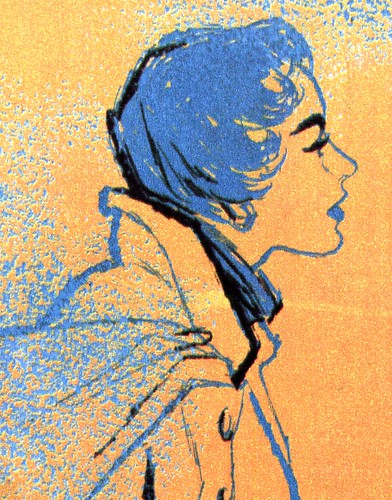
"Right...I said "she". Lucia... was a very classy lady in addition to being a talented illustrator. At a time when the profession was dominated by men Lucia more than held her own in the studio ranks."
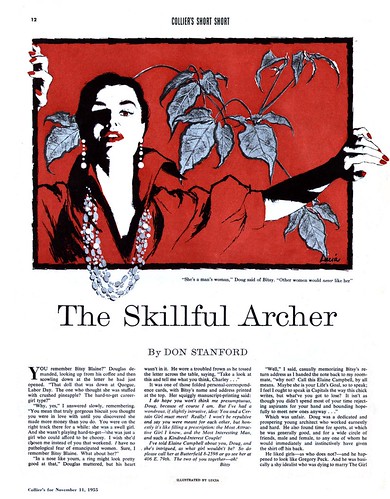
"Lucia was the only female artist around that I know of. Maybe other cities? But in the SBD family she was queen and treated accordingly."
So began a long and rewarding correspondence with Will, who related not only his recollections about the mysterious Lucia, but also a wealth of invaluable first-hand information about one of Chicago's premier art studios of the day - Stephens, Biondi, DeCicco.
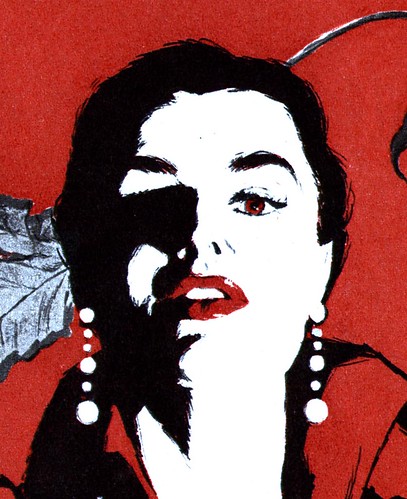
Lucia (pronounced "Loo-Shah") Lerner was "a shapely brunette, attractive, around 5'5'. I never saw her in anything but a conservative dark dress," wrote Will. "I don't remember her wearing anything else to work in. Her medium and style was a combination of india ink line and gouache washes. Much like others of the time who were using line and washes in inks."
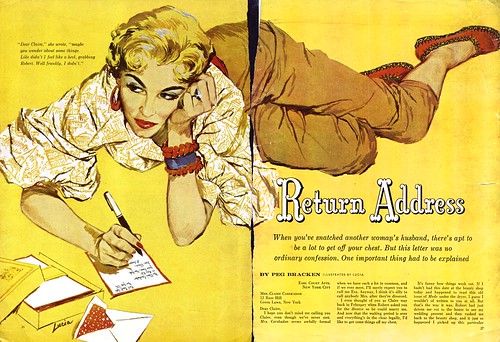
The November 1952 issue of Art Director & Studio News (the "Special Chicago Issue") contains a couple of interesting pages relevent to Lucia and SBD: first is this ad announcing the formation of the studio.
"I do remember that starting SBD required getting some top talent to come in...one of those was Lucia," wrote Will.
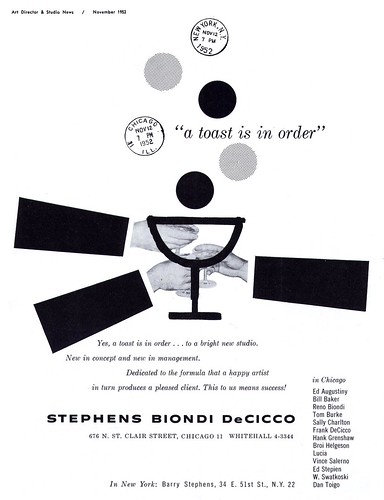
Second is this page highlighting a tradition of fashion illustration in the Chicago commercial art scene. Will wrote, "Lucia was a unique individual. We often played chess on lunch breaks...I seldom won a match...and she would talk about her art and how she grew into illustration from a newspaper, fashion artist, background. I think her style evolved from the desire to be different from the several other figure artists in the studio."
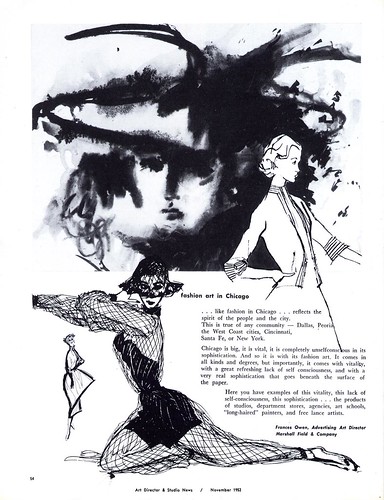
"You have to remember that Chicago was the "product" center of the U.S. We were heavy into foods, electronics, fashion related areas like cosmetics, etc. So...Lucia was always in demand in the ad agencies. The sales people were always trying to get her for their respective accounts."

"We were always competing with Cooper for editorial assignments. Barry Stephens constantly sought new samples from all of us to show in New York."
"I think [Lucia] enjoyed the work out of New York more for the change from agency assignments than for the work itself. She was very confident in her career and had her own idea about what her work was worth."
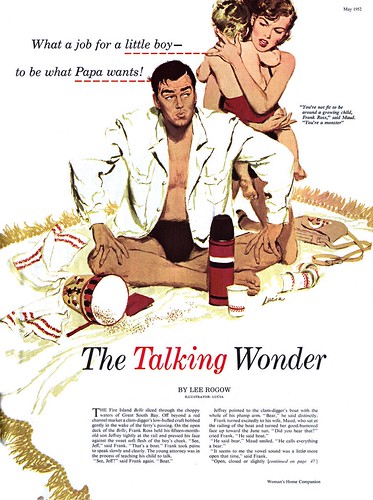
"She seemed rather indifferent to other illustrators and rarely commented on changing styles or other artists."
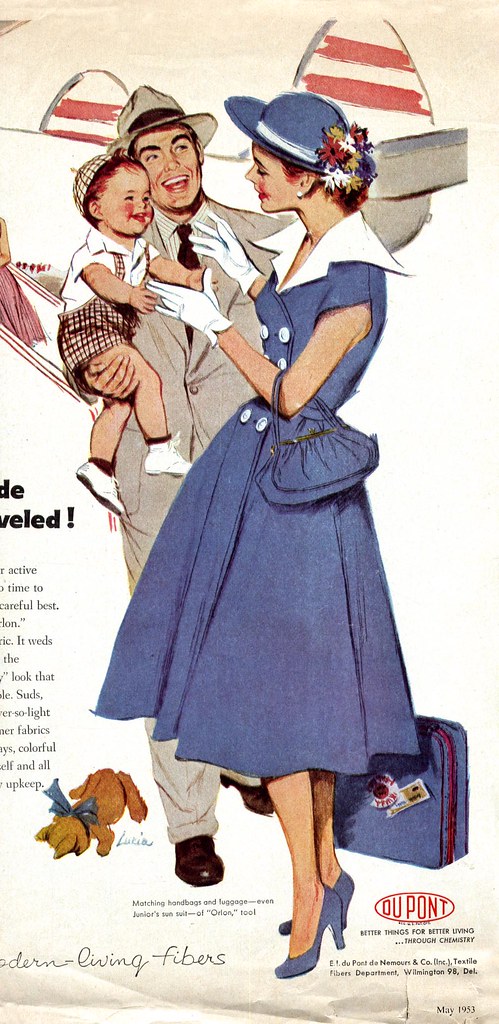
Like another female illustrator from 1950's Chicago, Joyce Ballentyne, who can claim a long-standing American icon as her own (she created the Coppertone girl), Lucia is responsible for the 1950's redesign of the Morton Salt girl as she would appear on millions of packages throughout that decade.
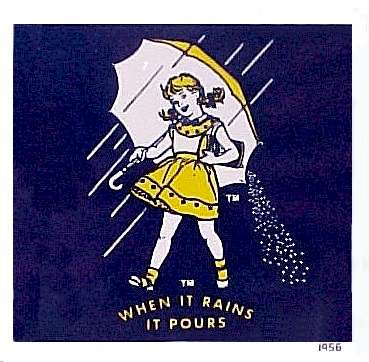
I found two ads from the 50's of the Morton Salt girl - but this one, from 1952, looks like it came out of the Sundblom studio (or perhaps it is also by Ballentyne).
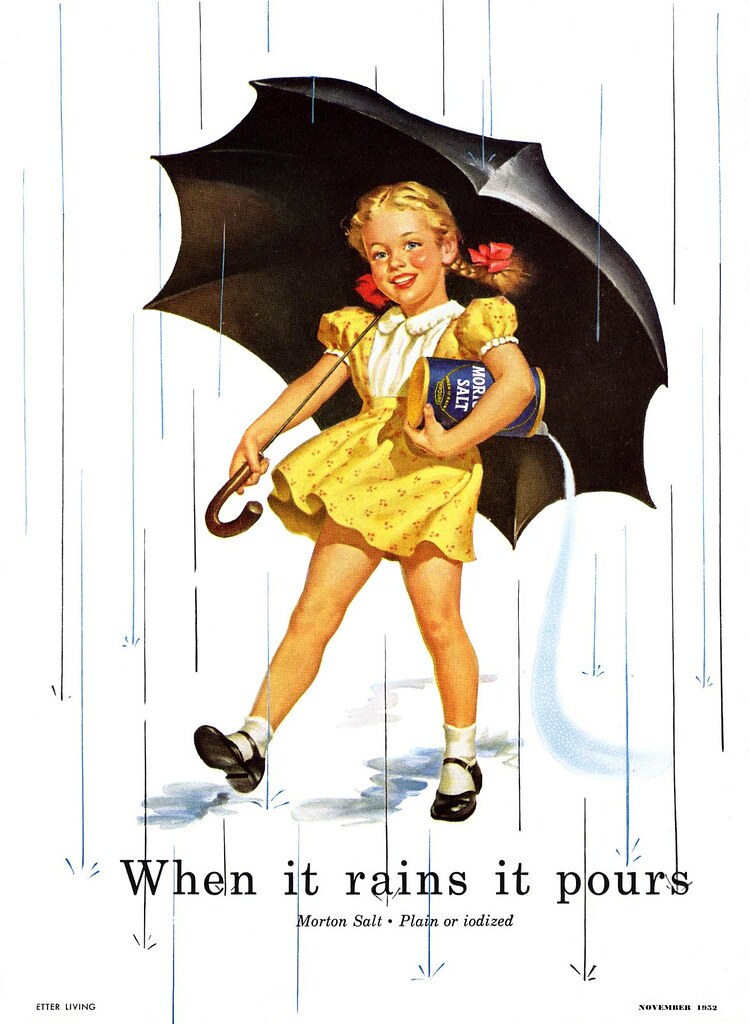
I thought I had hit the jackpot with this 1957 ad... but Will wrote, "[This] Morton Salt girl looks like a version done after Lucia's ...hers was more of an outline technique. This one could have been done by any number of illustrators around Chicago in the fifties."
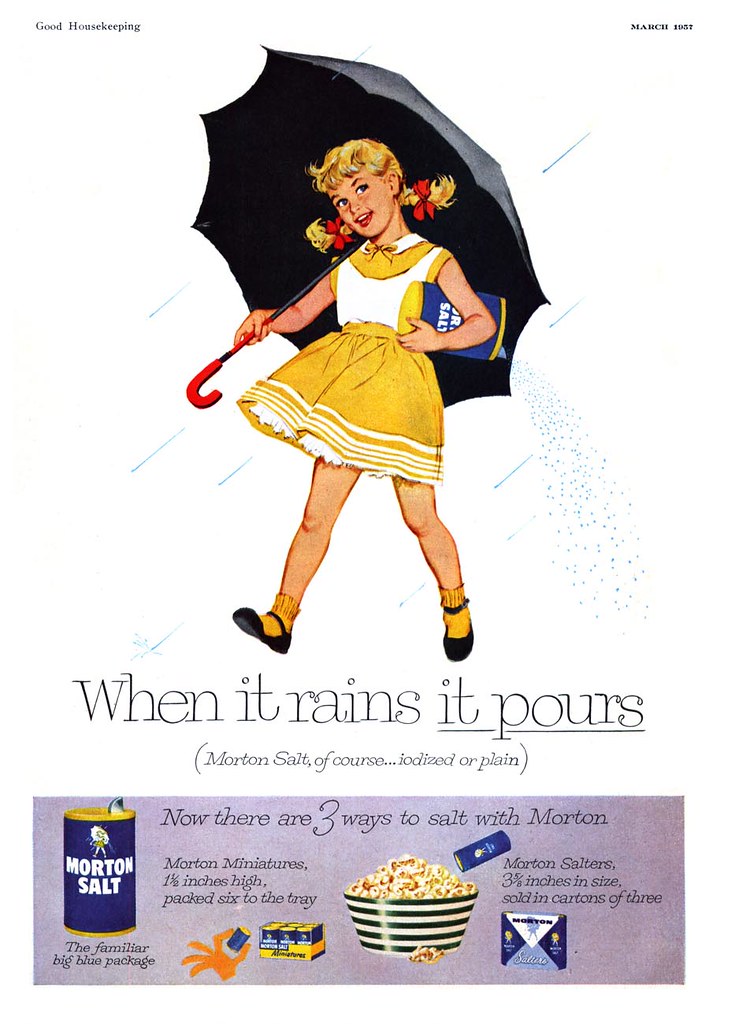
Nonetheless, all these pieces are great examples of the type of work top illustrators in Chicago like Lucia Larner might have been expected to do.
Some time ago I spoke with another Chicago artist, Carl Kock, who began his career at Stephens, Biondi, DeCicco in the late 50's. As Carl put it, he did not fit the mold of the typical commercial artist who could draw "good-looking people standing next to a refrigerator". His work was too avante garde, too stylized. But this was the type of work Lucia excelled at. It was the sort of high paying, high profile work SBD wanted its artist to do, and that made Lucia a valuable commodity for SBD's salesmen.

Will Nelson wrote, "Hotpoint was one of the accounts we had for quite some time. Lucia was always in demand in the ad agencies. The sales people were always trying to get her for their respective accounts."
"Her studio was the only one with a private counter and sink....the rest of us shared individual two man studios. You knew you had "arrived" when you were placed on the north side of the building."
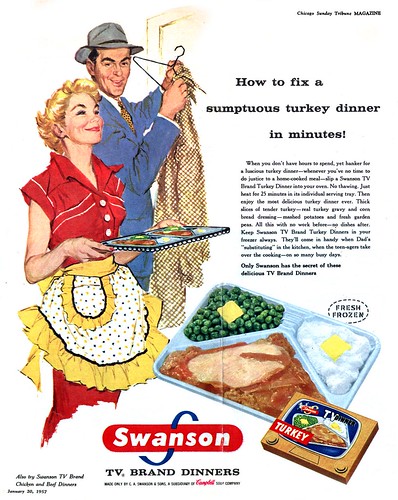
For those of us working in commercial art today its a point of interest to hear how similar - or different - the circumstances of payment were half a century ago. We learned in previous posts on Today's Inspiration that at the Cooper studio in New York the artists were free to keep all the money earned from editorial assignments -- the studio took no commission at all. And at Rahl studios, where Andy Virgil worked, in-house artists received 60% of commissions while the studio took 40%.
Will explained the circumstances at SBD in those days:
"All of the staff artists were on commission...no salaries, but very comfortable "draws". From my stand point....my monthly draw was like a salary, which was brought up to par with quarterly updates...referred to as extra draws which picked up the additional amounts credited to my account from billing activity. I was fortunate in that I was always ahead of the amount of my draw."
"The sales rep [at SBD] was Vince Salerno and he was always crossing swords with Lucia over fees quoted. She had her own idea about what her work was worth...and held her ground until she got it."
"Like I said earlier, she was a class act."
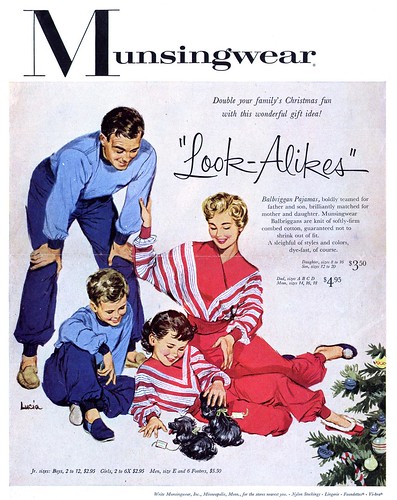
Ken Krull, who was a salesman at Stephens, Biondi, DiCicco, when Lucia worked there during the 50's, confirms Will's description with the following anecdote:
Bringing up Lucia's name reminded me of our first job to together," wrote Ken. "I had just started in sales at SBD in the late 50's. An art director from FCB wanted to use Lucia on an ad featuring two women's heads. His budget was $200 (this was the 50's). I approached Lucia with the layout. Her question was "What will this bill for?" [When I told her the budget] she said, "That's really not very good - plus I'm very busy." Her way of turning down work."
Disappointed, I left, forgetting to take the layout. Next morning when I arrived the finished art of the heads was on my desk with a note... "Ken; Don't tell anyone what these billed for." "L"
"We went on to do much work together...She was the Queen."
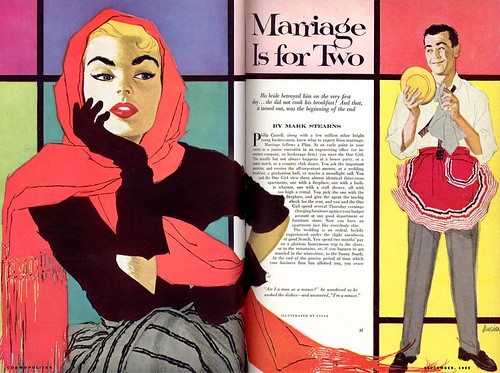
"It's only these last few years that I have come to appreciate just how young I was when I was on staff with the Stephens, Biondi and DeCicco Studios," wrote Will Nelson in his first long letter to me. "Through an extraordinary sequence of events I went from Art Center College, Los Angeles, to the SBD studio headquarters, Chicago, in less than six months. I was on staff with a group of artists fifteen to twenty years older than me."
"Being single, I was on my own in Chicago. My time spent in the studio with the staff ended after 5:00. Lucia was an exception...she invited me to some of her friends' poker games."

"She had a male friend at the time whom I only met a couple of times (he was a reporter with the Chicago Tribune)."
"Lucia had a daughter she was raising on her own. She was very private about her so I can't add much more. I think she was about 12 years old at that time... around 1956 or '57... but I can't be sure."

Reading this last part of Will's correspondence felt like a bomb going off.
Having read up to this point, I'm sure you must have felt (as I do) that Lucia Larner was not only an exceptionally talented and successful illustrator, but a strong-willed and confident woman, determined to succeed despite the hurdles of prejudice and chauvinism that she must surely have encountered in the "man's world" of commercial art.
To discover that she was dealing with the additional challenges of being a single mother in 1950's America is truly stunning -- and only makes me admire and respect her all the more.

Younger people may find my emphasis of this point a little odd... but anyone who grew up even as late as the 1970's, as I did, will probably recall how rare it was to know a kid who came from a single-parent household - and the stigma attached to that situation.
Go back another 20 years and try to imagine how daunting it would be to step out the door each morning and face the societal attitudes of America in the 1950's. I think you'll begin to appreciate what I'm getting at.

Knowing now that Lucia Larner was a single mother, I can't help but look back over her body of work and take note of how often she created scenes of mother and daughter - with no man present.

And perhaps assignments such as these seen here today were all the more meaningful to her considering her unique (and challenging) personal circumstances.
Will added, "Did I mention your site came up somewhere along the line after I put Lucia's name on Google in hopes of finding out if she was still around? And this was probably the first I had thought of her in several years. All of this brings back vivid memories of the studio and the wonderful experience it was."

"We occupied the top 7th floor on Ohio St. Just a block off Michigan Ave. Next door to the studio was a upstart publishing group with a new magazine called Playboy."
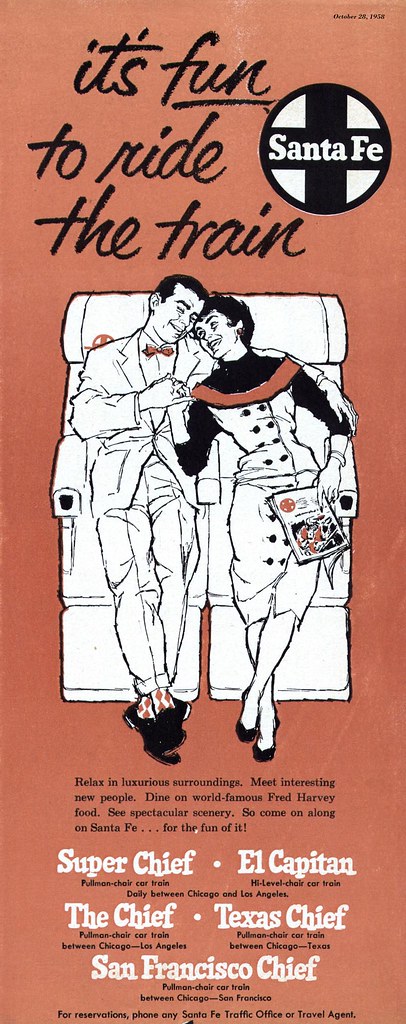
"Barry Stephens constantly sought new samples from all of us to show in New York. I was sent to New York for a couple of months to work on large toy project requiring extra hands. Getting work out of New York was considered a major accomplishment...and Lucia did do well."

"I think Lucia may have come from the same previous studio base as Reno (Biondi) and Frank (DeCicco). They had worked together prior to starting SBD."
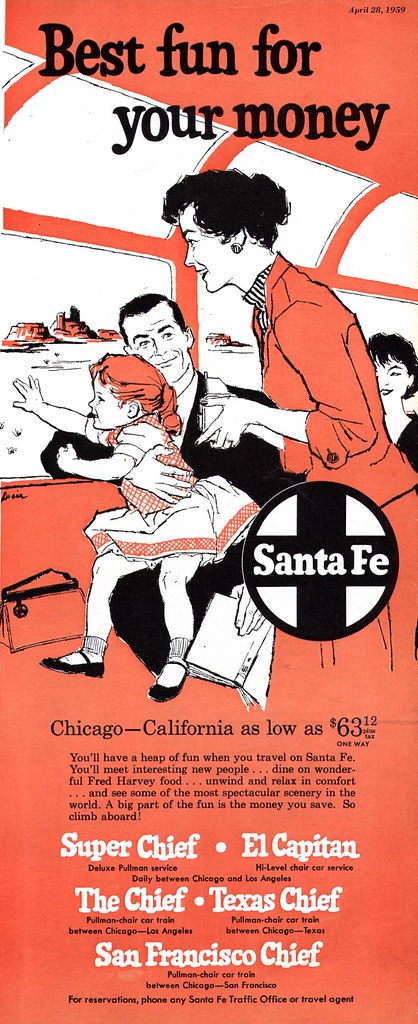
"Lucia moved to the L.A. studio (of SBD) when she left Chicago. Dan Toigo (he was featured a few years later in the American Artist magazine for his watercolors) went at the same time. I saw both of them a year or two later at SBD in L.A. while on a vacation trip. As I recall, Lucia was immediately in demand in the high end fashion market...I. Magnin, Bullocks, etc. I assume she fell back on her considerable fashion skills."
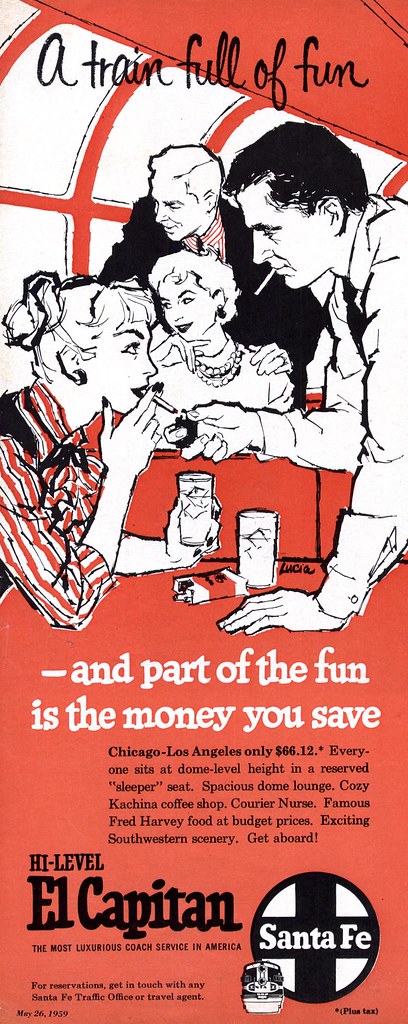
"I lost track of her after about 1960. I just don't know if she is still with us or not."

After Lucia moved to SBD's L.A. office, she did the piece below for Petersen Publishing's Teen magazine.
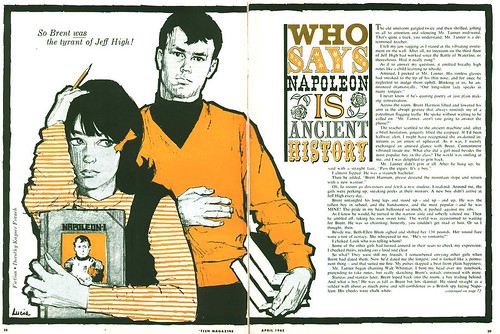
Long-time TI list member, Armando Mendez, who was kind enough to send me the scan, added this bit of chronology to the Lucia story:
The month before [March 1965] had another very stylish Lucia DPS illustration with a dark-haired girl (who could be based on the same model) reading through old magazines but without the heavy containment line and flat blacks of this month; a very open, sketchy, continous line Briggs/Fawcett (lithographic crayon) type drawing. I don't have a complete run but I can tell you a year later and what little story illustration remains would be 180 degees different in approach.
Around that same time, wrote Armando, "The large department stores ran incredible full page fashion drawings in the two main [L.A.] newspapers (even as a young boy, the drawings amazed me) but weren't signed. I certainly think Lucia had the chops for these."
That jibes well with Will Nelson's thoughts on what became of Lucia: "As I recall, Lucia was immediately in demand in the high end fashion market... I.Magnin, Bullocks, etc."
Perhaps someone out there will have saved some of those 1960's newspaper fashion ads and will read this post. With a little luck, we may yet get to see Lucia Lerner's work from that later part of her career.
In February 2009, the following comment was added to one of my early Lucia posts:
"Hi, I ran across your blogs about Lucia Larner while researching an art piece that has been passed down through the family. She was my grandmother's sister. She was a wonderful woman who used to visited us randomly throughout the years. She has finally passed away several years ago from what my mother told me. She was always fun to visit with. She had a very vibrant and fun personality. She would always share stories about the art she was involved in." - Adam
* My Lucia Larner Flickr set

Lucia was clearly adept at painting georgous women in romantic settings. His work had a lively roughness, a sketchiness - that textural quality - that was emerging during the mid-fifties among the top boy/girl illustrators, especially those at the Cooper studio in New York.
I say "his" because at that time I presumed only male illustrators could have done work in this sort of style. Shows you how very little I knew at the time!
But with no listing in "Illustrator in America" and with my most knowledgeable contacts unable to shed any light on who "he" was, Lucia remained just a signature on the occassional magazine ad I came across. Lucia's accounts included Gibson greeting cards, Orlon textiles, and the Santa Fe rail line. For the longest time I thought Lucia was strictly an advertising illustrator... then I discovered pieces like this one below, proving that the artist had also done editorial work.

I found pieces in Collier's, American, and Better Living, always signed ( or even just credited ) with that single name: Lucia.

Then, in 2006, an email arrived out of the blue: "I have info about Lucia for you..."
Those seven words sent an electric thrill through me. An illustrator named Will Nelson had stumbled upon my post and decided to contact me.

Will began relating to me his recollections of working as a young up-and-coming illustrator in the 1950's at the Chicago powerhouse art studio, Stephens, Biondi, DeCicco:
"When I came on board," wrote Will, "there were about ninety people in the organization. When I started right out of Art Center the head of the Los Angeles studio was Howie Forsberg, an illustrator, along with a staff which included Fritz Willis and Morgan"Joe"Henninger. It was in Chicago that I met Lucia (last name Larner)."

Hearing all this from Will absolutely blew my mind! Up to this point I had not even realized that Lucia was a woman. Since commercial art was, relatively speaking, a "boys club" in the 50's, I had presumed that "Lucia" was a male artist's last name. But Will set me straight:

"Right...I said "she". Lucia... was a very classy lady in addition to being a talented illustrator. At a time when the profession was dominated by men Lucia more than held her own in the studio ranks."

"Lucia was the only female artist around that I know of. Maybe other cities? But in the SBD family she was queen and treated accordingly."
So began a long and rewarding correspondence with Will, who related not only his recollections about the mysterious Lucia, but also a wealth of invaluable first-hand information about one of Chicago's premier art studios of the day - Stephens, Biondi, DeCicco.

Lucia (pronounced "Loo-Shah") Lerner was "a shapely brunette, attractive, around 5'5'. I never saw her in anything but a conservative dark dress," wrote Will. "I don't remember her wearing anything else to work in. Her medium and style was a combination of india ink line and gouache washes. Much like others of the time who were using line and washes in inks."

The November 1952 issue of Art Director & Studio News (the "Special Chicago Issue") contains a couple of interesting pages relevent to Lucia and SBD: first is this ad announcing the formation of the studio.
"I do remember that starting SBD required getting some top talent to come in...one of those was Lucia," wrote Will.

Second is this page highlighting a tradition of fashion illustration in the Chicago commercial art scene. Will wrote, "Lucia was a unique individual. We often played chess on lunch breaks...I seldom won a match...and she would talk about her art and how she grew into illustration from a newspaper, fashion artist, background. I think her style evolved from the desire to be different from the several other figure artists in the studio."

"You have to remember that Chicago was the "product" center of the U.S. We were heavy into foods, electronics, fashion related areas like cosmetics, etc. So...Lucia was always in demand in the ad agencies. The sales people were always trying to get her for their respective accounts."

"We were always competing with Cooper for editorial assignments. Barry Stephens constantly sought new samples from all of us to show in New York."
"I think [Lucia] enjoyed the work out of New York more for the change from agency assignments than for the work itself. She was very confident in her career and had her own idea about what her work was worth."

"She seemed rather indifferent to other illustrators and rarely commented on changing styles or other artists."

Like another female illustrator from 1950's Chicago, Joyce Ballentyne, who can claim a long-standing American icon as her own (she created the Coppertone girl), Lucia is responsible for the 1950's redesign of the Morton Salt girl as she would appear on millions of packages throughout that decade.

I found two ads from the 50's of the Morton Salt girl - but this one, from 1952, looks like it came out of the Sundblom studio (or perhaps it is also by Ballentyne).

I thought I had hit the jackpot with this 1957 ad... but Will wrote, "[This] Morton Salt girl looks like a version done after Lucia's ...hers was more of an outline technique. This one could have been done by any number of illustrators around Chicago in the fifties."

Nonetheless, all these pieces are great examples of the type of work top illustrators in Chicago like Lucia Larner might have been expected to do.
Some time ago I spoke with another Chicago artist, Carl Kock, who began his career at Stephens, Biondi, DeCicco in the late 50's. As Carl put it, he did not fit the mold of the typical commercial artist who could draw "good-looking people standing next to a refrigerator". His work was too avante garde, too stylized. But this was the type of work Lucia excelled at. It was the sort of high paying, high profile work SBD wanted its artist to do, and that made Lucia a valuable commodity for SBD's salesmen.

Will Nelson wrote, "Hotpoint was one of the accounts we had for quite some time. Lucia was always in demand in the ad agencies. The sales people were always trying to get her for their respective accounts."
"Her studio was the only one with a private counter and sink....the rest of us shared individual two man studios. You knew you had "arrived" when you were placed on the north side of the building."

For those of us working in commercial art today its a point of interest to hear how similar - or different - the circumstances of payment were half a century ago. We learned in previous posts on Today's Inspiration that at the Cooper studio in New York the artists were free to keep all the money earned from editorial assignments -- the studio took no commission at all. And at Rahl studios, where Andy Virgil worked, in-house artists received 60% of commissions while the studio took 40%.
Will explained the circumstances at SBD in those days:
"All of the staff artists were on commission...no salaries, but very comfortable "draws". From my stand point....my monthly draw was like a salary, which was brought up to par with quarterly updates...referred to as extra draws which picked up the additional amounts credited to my account from billing activity. I was fortunate in that I was always ahead of the amount of my draw."
"The sales rep [at SBD] was Vince Salerno and he was always crossing swords with Lucia over fees quoted. She had her own idea about what her work was worth...and held her ground until she got it."
"Like I said earlier, she was a class act."

Ken Krull, who was a salesman at Stephens, Biondi, DiCicco, when Lucia worked there during the 50's, confirms Will's description with the following anecdote:
Bringing up Lucia's name reminded me of our first job to together," wrote Ken. "I had just started in sales at SBD in the late 50's. An art director from FCB wanted to use Lucia on an ad featuring two women's heads. His budget was $200 (this was the 50's). I approached Lucia with the layout. Her question was "What will this bill for?" [When I told her the budget] she said, "That's really not very good - plus I'm very busy." Her way of turning down work."
Disappointed, I left, forgetting to take the layout. Next morning when I arrived the finished art of the heads was on my desk with a note... "Ken; Don't tell anyone what these billed for." "L"
"We went on to do much work together...She was the Queen."

"It's only these last few years that I have come to appreciate just how young I was when I was on staff with the Stephens, Biondi and DeCicco Studios," wrote Will Nelson in his first long letter to me. "Through an extraordinary sequence of events I went from Art Center College, Los Angeles, to the SBD studio headquarters, Chicago, in less than six months. I was on staff with a group of artists fifteen to twenty years older than me."
"Being single, I was on my own in Chicago. My time spent in the studio with the staff ended after 5:00. Lucia was an exception...she invited me to some of her friends' poker games."

"She had a male friend at the time whom I only met a couple of times (he was a reporter with the Chicago Tribune)."
"Lucia had a daughter she was raising on her own. She was very private about her so I can't add much more. I think she was about 12 years old at that time... around 1956 or '57... but I can't be sure."

Reading this last part of Will's correspondence felt like a bomb going off.
Having read up to this point, I'm sure you must have felt (as I do) that Lucia Larner was not only an exceptionally talented and successful illustrator, but a strong-willed and confident woman, determined to succeed despite the hurdles of prejudice and chauvinism that she must surely have encountered in the "man's world" of commercial art.
To discover that she was dealing with the additional challenges of being a single mother in 1950's America is truly stunning -- and only makes me admire and respect her all the more.

Younger people may find my emphasis of this point a little odd... but anyone who grew up even as late as the 1970's, as I did, will probably recall how rare it was to know a kid who came from a single-parent household - and the stigma attached to that situation.
Go back another 20 years and try to imagine how daunting it would be to step out the door each morning and face the societal attitudes of America in the 1950's. I think you'll begin to appreciate what I'm getting at.

Knowing now that Lucia Larner was a single mother, I can't help but look back over her body of work and take note of how often she created scenes of mother and daughter - with no man present.

And perhaps assignments such as these seen here today were all the more meaningful to her considering her unique (and challenging) personal circumstances.
Will added, "Did I mention your site came up somewhere along the line after I put Lucia's name on Google in hopes of finding out if she was still around? And this was probably the first I had thought of her in several years. All of this brings back vivid memories of the studio and the wonderful experience it was."

"We occupied the top 7th floor on Ohio St. Just a block off Michigan Ave. Next door to the studio was a upstart publishing group with a new magazine called Playboy."

"Barry Stephens constantly sought new samples from all of us to show in New York. I was sent to New York for a couple of months to work on large toy project requiring extra hands. Getting work out of New York was considered a major accomplishment...and Lucia did do well."

"I think Lucia may have come from the same previous studio base as Reno (Biondi) and Frank (DeCicco). They had worked together prior to starting SBD."

"Lucia moved to the L.A. studio (of SBD) when she left Chicago. Dan Toigo (he was featured a few years later in the American Artist magazine for his watercolors) went at the same time. I saw both of them a year or two later at SBD in L.A. while on a vacation trip. As I recall, Lucia was immediately in demand in the high end fashion market...I. Magnin, Bullocks, etc. I assume she fell back on her considerable fashion skills."

"I lost track of her after about 1960. I just don't know if she is still with us or not."

After Lucia moved to SBD's L.A. office, she did the piece below for Petersen Publishing's Teen magazine.

Long-time TI list member, Armando Mendez, who was kind enough to send me the scan, added this bit of chronology to the Lucia story:
The month before [March 1965] had another very stylish Lucia DPS illustration with a dark-haired girl (who could be based on the same model) reading through old magazines but without the heavy containment line and flat blacks of this month; a very open, sketchy, continous line Briggs/Fawcett (lithographic crayon) type drawing. I don't have a complete run but I can tell you a year later and what little story illustration remains would be 180 degees different in approach.
Around that same time, wrote Armando, "The large department stores ran incredible full page fashion drawings in the two main [L.A.] newspapers (even as a young boy, the drawings amazed me) but weren't signed. I certainly think Lucia had the chops for these."
That jibes well with Will Nelson's thoughts on what became of Lucia: "As I recall, Lucia was immediately in demand in the high end fashion market... I.Magnin, Bullocks, etc."
Perhaps someone out there will have saved some of those 1960's newspaper fashion ads and will read this post. With a little luck, we may yet get to see Lucia Lerner's work from that later part of her career.
In February 2009, the following comment was added to one of my early Lucia posts:
"Hi, I ran across your blogs about Lucia Larner while researching an art piece that has been passed down through the family. She was my grandmother's sister. She was a wonderful woman who used to visited us randomly throughout the years. She has finally passed away several years ago from what my mother told me. She was always fun to visit with. She had a very vibrant and fun personality. She would always share stories about the art she was involved in." - Adam
* My Lucia Larner Flickr set

delighted to hear this story of an amazing woman!
ReplyDeleteThese are gorgeous. I especially like the 'Marriage is made for two' and 'The patter of tiny feet' ones. Emma
ReplyDeleteJust a return visit to tell you that I found one of her pictures in a vintage Woman's Own magazine I have! It was illustrating a story called 'The Girl Who Wouldn't Hit Back'. I should be putting it up on my own blog within the next couple of days. Thanks for the information on her, really useful. Emma :)
ReplyDeleteWhat a great read! I bet the niece has passed this blogpost on to Lucia's daughter. Maybe more will be forthcoming.
ReplyDeleteNotice that Lucia worked late after the men went home. The old adage that a woman works twice as hard for half the recognition seems to hold. I'm impressed that she had the confidence to demand fair pay -- most people took it for granted then that women ought to be paid less.
Lucia was my Mom............And a great person.........So very you liked her work........Lori Larner not 'Lerner'.....alady0yes@yahoo.com
ReplyDeleteI am interested in the career of Ruth Stemm Morgan, my Grandmother. She lived and worked in Chicago in the 20's to the 50's. She did fashion sketches for ads in the newspapers, the covers of pamphlets for women's products like crochet thread, a paper toy called "My Whirly Gig Circus" and once, in the 50's was photographed for an ad for "Grandma's Jams" which appeared on the back of a Life magazine. Have you run across her name?
ReplyDeleteHello Lori, this is Jan Coker your cousin, my maiden name was Hoffman. My mother was Catherine, your mother's sister. coker@internode.on.net
ReplyDeleteHi, This is Adam again, grandson to Lucia's sister. Your blog is a wonderful story of Lucia's life. I would like to add some information about Lucia's origins. Lucia, came from a family of 4 siblings, Sophia, Katherine, Henry and Lucia. Their parents immigrated to the US from an area around Minsk Russia. Lucia was born here in the US. They are of Russian Jewish descent. When I was a child in the early 70's was also told that Lucia was the creator/illustrator for Tony the Tiger and the Little Green Sprout (haven't been able to verify that). My family has one her unpublished works, and I would love to share a picture. If you would like a pic of, my email address is mcclelak@yahoo.com . Thank you
ReplyDeleteHi. Adam. I just happened to be one of the step grand daughter in law of Patricia Parkin, Henry's widow, LUCIA's brother
DeletePATRICIA,almost 102 tells me about Lucia's work and told me that Lucia also was who made the original drawings of the Barbie doll. Tony the tiger was created by Jack Tolzin, PATRICIA'S cousin. Also SAID that her mom, Germaine and saw the first dresses for the Barbie doll. Unfortunatelly neither of them were recognized for all these creations.
Pat, my second cousin, has talked about this same information as the person who corrected the author about Jack Tolzein, who was also my second cousin. She’s shared this information with me for 30 years. Lucia Larner, the famous illustrator, was Pat’s sister in law & Jack Tolzein her first cousin. Two talented illustrators’ work became confused somewhere but are connected by the Rondenet family tree.
DeleteSorry, one other note about Lucia. As I stated before "She had a very vibrant and fun personality". Lucia was like Rosalyn Russell in Auntie Mame. See was always hi spirited, love of life and people, caring and fun.
ReplyDeleteSenang bisa menikmati permainan Slot Gacor Hari Ini Deposit Pulsa 10 Ribu Bebas Potongan Terpercaya!
ReplyDelete